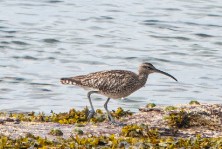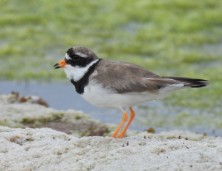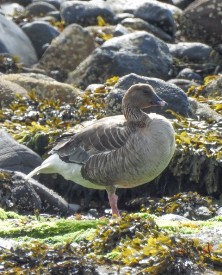July 2024
Bird Sightings



In July the strange unsettled summer continued. In comparison to June, July was a little warmer with similar rainfall. In comparison to last July, this July had half the rain of last year. The impact on the breeding success of most our visiting summer birds, particularly those that relied on airborne insects to feed young was mixed. Hirundines do not seem to be doing as well as last year. The impact on other summer visitors will become apparent when the information from licensed ringers on the proportion of adult to young birds becomes available. From reports across the island, Blackbird and Song Thrush are having a good breeding season but concern was being expressed about the absence of juvenile Blue Tit, Coal Tit and Great Tits. On the other hand, Goldfinch and Linnet had a good breeding season.
Other signs of a successful breeding season included: family of Shelduck at Kildonan on 2nd, female Eider with five young at Blackwaterfoot also on 2nd, pair of Mute Swan with four young in Sannox Bay on 10th, young Moorhen and young Little Grebe in Mossend Pond on 16th, pair of Canada Geese with six young on Pladda on 24th, a family of Spotted Flycatcher using a window flower box in Whiting Bay on 24th, a family of Common Sandpiper at Kilpatrick Point on 31st plus young reported at all island heronies. Golden Eagle, Hen Harrier, Peregrine and Kestrel were all reported with young.
On the downside, there is an ongoing concern about disturbance on shores of nesting Oystercatcher and nesting Ringed Plover by dog walkers. In addition, diminishing records of breeding Curlew, Fulmar and Lapwing is a continuing cause for concern.
July marks the end of the breeding season for some birds. It can be an interesting time looking for breeding species dispersing from their breeding grounds, many still in their breeding plumage. Reports included; twelve Turnstone in Catacol Bay on 8th, six Dunlin on Silver Sands on 10th, a Whimbrel in Kildonan on 15th, a Kingfisher in Brodick on 16th, three Black-headed Gull (More info here) on Silver Sands on 17th, two Sandwich Tern in Kildonan on 22nd and a Golden Plover at Drumadoon Point on 23rd.
In addition, after breeding many species begin to flock together. Reports included; three hundred and fifty Starling at Shannochie on 8th, forty-four Herring Gull at Sannox Bay on 10th, twelve Red-breasted Merganser in Machrie Bay on 17th, one hundred and twenty Jackdaw in Kilpatrick on 19th, twenty-two Ringed Plover at Drumadoon Point on 21st, twenty Curlew at Clauchlands, two hundred Kittiwake on Pladda, two hundred and thirty Manx Shearwater off Sliddery Shore and fifty-one Shag in Porta Buidhe all on 28th.
In July 2022, Highly Pathogenic Avian Influenza ( HPAI) H5N1 arrived on Arran. By the end of July 2022 over 350 dead birds had been recorded. This July there were no confirmed cases on Arran in either wild or captive birds but in the UK, H5N1 is still prevalent. Its impact is perhaps most obvious when looking from Arran at Ailsa Craig which is usually white with Gannet at this time of year. This year, with fewer birds, it is noticeably less white.
Over a hundred species were reported in July. Other highlights included a leucistic Siskin in Cordon on 6th, seven Black Guillemot in Brodick Bay on 12th, a White-tailed Eagle over Meall Mor also on 12th, two Red-throated Diver in Pirnmill on 13th, four Arctic Tern off the Cock of Arran on 27th, a Puffin off Sliddery shore on 28th, a Long-eared Owl in Pirnmill on also on 28th, an over-summering Pink-footed Goose with two over-summering Whooper Swan (More info here) at Clauchlands on 29th and two Goosander at Balliekine shore on 31st. Finally, the last date that I have for Cuckoo is 18th when one juvenile was reported in Tormore.


